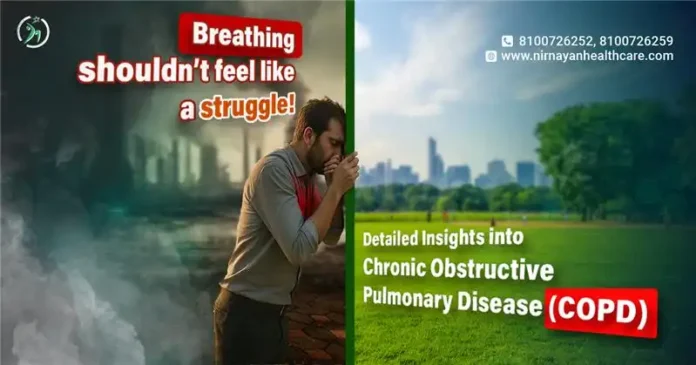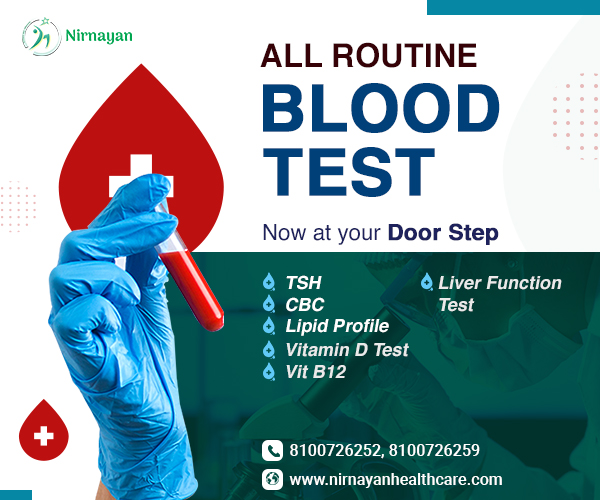Chronic obstructive pulmonary disease (COPD) is a progressive lung disease that often leads to a life-threatening condition with various consequences, including shortness of breath, breathing difficulty, and more. It involves lung function, which is primarily responsible for our breathing process. Chronic or persistent COPD hinders a happy life and may complicate life with serious illnesses, including heart disease.
As per the WHO, it is the third leading health condition that causes death. So let’s understand the Symptoms & Causes of COPD, and learn how to get over it.
What is chronic obstructive pulmonary disease (COPD)?
COPD is a group of long-term lung diseases—primarily emphysema and chronic bronchitis—that cause obstruction in the airways and difficulty moving air in and out of the lungs. People with either chronic bronchitis or emphysema are at higher risk of developing COPD. In simple terms, COPD occurs when airflow to your lungs is blocked, making breathing difficult and gradually damaging lung tissue.
Overview of COPD:
COPD occur when your lungs’ airways limit the airflow in and out, and those obstructions can cause trouble breathing, chronic bronchitis, and other lung diseases.
Causes of COPD:
The most common cause of COPD is cigarette smoking, with up to 85% of cases linked to long-term exposure to smoke, fumes, or other dust exposures.
Asthma is a common concern for developing COPD due to narrow airways and swelling, and excess mucus production. Asthma and chronic cough, along with smoking, rapidly increase the risks of COPD in patients. Including other respiratory diseases, your lungs get weak.
Other contributing factors include:
- Long-term exposure to toxic fumes, gases, air pollution, or dust
- Secondhand smoke exposure
- Asthma, which increases susceptibility due to airway inflammation
- Genetic factors, such as Alpha-1-antitrypsin deficiency
- Low immunity or frequent respiratory infections
Symptoms of COPD:
There are various signs of COPD, including
- Breathing problem (Shortness of breath, especially during activities)
- Chest tightness
- Persistent coughing
- Excess mucus production
- A wheezing sound while breathing
- Repeated respiratory infections
- Unnecessary weight loss
- Shortness of breath while moving or doing any activity
What is the difference between asthma and COPD?
Asthma and COPD are both lung diseases, and have the same symptoms, like breathing problems, chest pain, chest tightness, and shortness of breath. But Asthma can be exposed to allergic components like dust, pollen, and mould. On the other hand, COPD develops with emphysema and chronic bronchitis.
Studies show that childhood asthma significantly increases the risk of developing COPD later in life. While some children may outgrow asthma, others may experience underdeveloped or less efficient lungs compared to those without a history of asthma. Experts believe that asthma either directly contributes to the development of COPD or serves as a key factor in making it more likely in adulthood.
COPD Risk Factors:
COPD is rapidly known as smoker’s disease, but some risk factors also contribute higher chance of COPD in people. It is proven that some people who do not smoke also get COPD. Even non-smokers can develop COPD. Other risk factors include:
- People who are more exposed to dust, factory smoke, or dust mites
- Asthma patients are at a higher risk of respiratory diseases
- Family history of COPD also contributes to getting higher chance of COPD
- For older people who have low immunity
- People who have other respiratory illnesses
Complications of COPD:
Early warning signs of COPD are mostly related to your breathing problem and lung health. If untreated, COPD can lead to serious health issues:
- Pneumonia and lung infections
- Lung collapse (pneumothorax)
- Low blood oxygen (hypoxemia)
- Chronic cough and mucus blockage
- Pulmonary hypertension
- Heart disease and heart failure
- Increased risk of lung cancer (especially among smokers)
Stages of COPD:
COPD severity is measured by lung function (FEV1 test) and symptoms:
| Stage | Severity | Description |
| Stage 1 – Mild | FEV1 ≥ 80% | Mild cough, often unnoticed |
| Stage 2 – Moderate | FEV1 50–79% | Persistent cough, breathlessness during activities |
| Stage 3 – Severe | FEV1 30–49% | Frequent symptoms, difficulty doing daily tasks |
| Stage 4 – Very Severe | FEV1 < 30–50% | Severe breathing issues, even at rest, oxygen support is often required |
Pneumonia:
Lung infections make your lungs more weak to fight off any diseases, and also decrease your immunity to overcome. Infections like Pneumonia, when you get sick, can further complicate your breathing. Some vaccines protect against pneumonia, while others guard against illnesses like the flu and wheezing cough, which can increase your risk.
Lung Collapse (Pneumothorax):
As lung tissues are getting damaged due to COPD, lung functions can be compromised with chest discomfort, pain, or tightness. You need urgent medical assistance to avoid any uneasy situation.
Oxygen Deprivation (Hypoxemia):
COPD can cause low oxygen levels in the blood (hypoxemia), which can lead to confusion, fatigue, and even organ failure if not treated properly.
Chronic Cough and Excessive Mucus Production:
A chronic cough and excess mucus production are common in COPD, leading to difficulty clearing the airways, increased risk of infections, and more frequent inflammations.
Pulmonary Hypertension:
The reduced oxygen levels caused by COPD can lead to pulmonary hypertension (high blood pressure in the arteries of the lungs), which can worsen heart and lung function.
COPD and Heart Disease Connection:
COPD increases the chances of developing heart diseases due to low oxygen levels, breathing problems, and increased pressure in the pulmonary arteries. This can lead to heart failure, arrhythmias, and other heart-related issues.
Lung Cancer:
Individuals with COPD, particularly those who smoke, have an elevated risk of developing lung cancer. The damage caused to the lungs by COPD increases susceptibility to cancerous changes.
Stages of COPD and their symptoms:
COPD patients may often experience trouble with chest tightness, breathing problems, and a chronic cough. According to the severity of symptoms, COPD can be divided into 4 subtypes:
Stage 1 (Mild COPD): This is the acute and mild stage, when you have COPD at a mild level. At this time, you don’t have any symptoms to notice; rather, a mild cough may be noticeable. FEV1 (Forced Expiratory Volume in 1 second) will be more than or similar to normal, that is, more than 80%.
Stage 2 (Moderate COPD): In this stage, symptoms can worsen from mild to persistent with chronic cough, chest tightness, and breathing problems while doing heavy work. FEV1 is 50% – 79% of normal.
Stage 3 (Severe COPD): It is considered the severe stage of COPD according to the symptoms and causes of COPD. Your symptoms include chronic coughing, difficulty in breathing, chest tightness, a wheezing cough, and even being unable to come out of home.
Stage 4 (Very Severe COPD): At this stage, the damage to the lungs is extensive, and symptoms are very debilitating. People may experience continuous breathing issues, even at rest, and may require assistance with daily activities. Frequent exacerbations and hospitalisations are common. The FEV1 will be less than 50% of normal with chronic respiratory failure.
How to prevent COPD flare-ups?
Chronic obstructive pulmonary disease (COPD) can flare up with risk factors and smoking. There are some tips you can follow,
- Stop smoking and avoid any secondhand smoke as soon as possible after being diagnosed with COPD and any other lung disorders.
- Avoid people who have a chronic cough and the flu
- Follow breathing exercises, medical guidance as suggested
- Be strict with medication courses to manage COPD complications
- Do regular health checkups and tests as recommended
- Take oxygen as per the recommendation
How to reduce COPD symptoms naturally?
It is difficult to live with Chronic Obstructive Pulmonary Disease (COPD), but there are some ways you can manage symptoms and improve lung health.
- Smoking is the leading cause of COPD, and continuing to smoke will only worsen your symptoms. By quitting, you’ll significantly slow down COPD flare-ups.
- COPD exercise is a critical part of managing your symptoms naturally. Breathing exercises, such as pursed-lip breathing and diaphragmatic breathing, are incredibly effective in COPD therapy. These techniques help improve air flow and reduce anxiety.
- Participate in a COPD therapy program designed to improve strength, mobility, and endurance.
- Pulmonary rehabilitation, which is often prescribed for COPD patients, includes supervised exercise and education to help you manage your symptoms and improve your quality of life.
- Keep track of your COPD symptoms and any changes you experience. Regular monitoring of your condition can help you detect exacerbations early and take necessary precautions.
Best treatment options for COPD patients:
Chronic Obstructive Pulmonary Disease (COPD) is a progressive lung disease that affects the lungs, making breathing difficult and leading to several health complications and lung diseases.
Your doctor may ask you about your COPD-related family history, other diseases, or ask about some exposures like smoking. Also, they may ask you to have some tests to assess your lung health.
Pulmonary Function Test:
This can be used for checking your current lung health and also to determine lung disorders, and even if COPD is found, then how much it has spread or confirm its stages for better treatment. In this test group, there are several types, including
- Spirometry Test
- Lung Volume Test
- Pulse oximetry
- Lung diffusion test
- Exercise stress test
Also, in addition, imaging tests such as a CT Scan and a Chest X-ray can be done for accurate diagnosis.
Instant relief Inhaler: The Doctor may suggest using of inhaler, which can give you instant relief from breathing problems, reduce lung infections, and decrease the risks of developing COPD.
There are mainly two types of inhalers that can be used. Short-acting bronchodilator inhalers are used to get relief from acute or short-term breathlessness and chest discomfort.
Long-acting bronchodilator inhalers can be recommended if your COPD lasts for a long time, and you have experienced chronic bronchitis and airflow limitation continuously, which flare-ups COPD more than short-term.
Medications: The Doctor may recommend several antibiotic courses, even some steroids for reducing lung infections. Generally, a 5-day course can be suggested.
Other blood tests: Your Healthcare professionals also ask you to have some routine blood tests or any special screenings for severe COPD.
Nirnayan Healthcare, the best Laboratory chain across Kolkata, offers wide and accurate diagnosis of all types of tests. Nirnayan offers Respiratory Viral Panel test, Respiratory Bacterial Panel Test for the COPD Patient.
Pulmonary Rehabilitation:
Pulmonary rehabilitation is an essential COPD therapy program designed to alleviate breathlessness, enhance physical activity, and boost overall quality of life. In this programme, you will come in a touch with a team of dedicated doctors, nurses, dieticians, respiratory therapists, and physical therapists.
How does air pollution affect COPD patients?
Through air pollution, tiny particles from vehicles, factories, mills, and other smoke exposures can cause COPD if your lungs are exposed to these exposures for a long time. Also, gases from burning fuels, woods, and even from vehicles can higher the chances of lung disorders, including COPD.
When to seek a doctor:
COPD is a lung disease which always needs urgent and timely medical treatment and care. If you have stage 1 or 2 COPD, you need regular health checkups and regular tests to confirm any development of COPD. But in severe cases, a doctor may suggest that you to strong medications and support systems whenever you need them. For any emergency, consult with your medical person instantly without delay.
Conclusion:
Some people are not aware of COPD in its first stage, but it is always suggested not to smoke, and maintaining a healthy diet, along with avoiding common COPD exposure, helps in preventing COPD. While every breath is important and you need urgent care and an accurate diagnosis of COPD, a chronic lung disease which is now common in all ages.




